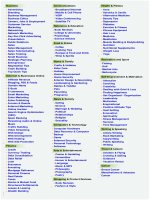Business Advertising Branding Business Management Business Ethics Careers, Jobs & Employment docx
Bạn đang xem bản rút gọn của tài liệu. Xem và tải ngay bản đầy đủ của tài liệu tại đây (3.62 MB, 367 trang )
Welcome To GetPedia.com : The Online Information Resource.
Search GetPedia
Business
Advertising
Branding
Business Management
Business Ethics
Careers, Jobs & Employment
Customer Service
Marketing
Networking
Network Marketing
Pay-Per-Click Advertising
Presentation
Public Relations
Sales
Sales Management
Sales Telemarketing
Sales Training
Small Business
Strategic Planning
Entrepreneur
Negotiation Tips
Team Building
Top Quick Tips
Internet & Businesses Online
Affiliate Revenue
Blogging, RSS & Feeds
Domain Name
E-Book
E-commerce
Email Marketing
Ezine Marketing
Ezine Publishing
Forums & Boards
Internet Marketing
Online Auction
Search Engine Optimization
(SEO)
Spam Blocking
Streaming Audio & Online
Music
Traffic Building
Video Streaming
Web Design
Web Development
Web Hosting
Web Site Promotion
Finance
Credit
Currency Trading
Debt Consolidation
Debt Relief
Loan
Insurance
Investing
Mortgage Refinance
Personal Finance
Real Estate
Taxes
Stocks & Mutual Fund
Structured Settlements
Leases & Leasing
Wealth Building
Communications
Broadband Internet
Mobile & Cell Phone
VOIP
Video Conferencing
Satellite TV
Reference & Education
Book Reviews
College & University
Psychology
Science Articles
Food & Drinks
Coffee
Cooking Tips
Recipes & Food and Drink
Wine & Spirits
Home & Family
Crafts & Hobbies
Elder Care
Holiday
Home Improvement
Home Security
Interior Design & Decorating
Landscaping & Gardening
Babies & Toddler
Pets
Parenting
Pregnancy
News & Society
Dating
Divorce
Marriage & Wedding
Political
Relationships
Religion
Sexuality
Computers & Technology
Computer Hardware
Data Recovery & Computer
Backup
Game
Internet Security
Personal Technology
Software
Arts & Entertainment
Casino & Gambling
Humanities
Humor & Entertainment
Language
Music & MP3
Philosophy
Photography
Poetry
Shopping & Product Reviews
Book Reviews
Fashion & Style
Health & Fitness
Acne
Aerobics & Cardio
Alternative Medicine
Beauty Tips
Depression
Diabetes
Exercise & Fitness
Fitness Equipment
Hair Loss
Medicine
Meditation
Muscle Building & Bodybuilding
Nutrition
Nutritional Supplements
Weight Loss
Yoga
Recreation and Sport
Fishing
Golf
Martial Arts
Motorcycle
Self Improvement & Motivation
Attraction
Coaching
Creativity
Dealing with Grief & Loss
Finding Happiness
Get Organized - Organization
Leadership
Motivation
Inspirational
Positive Attitude Tips
Goal Setting
Innovation
Spirituality
Stress Management
Success
Time Management
Writing & Speaking
Article Writing
Book Marketing
Copywriting
Public Speaking
Writing
Travel & Leisure
Aviation & Flying
Cruising & Sailing
Outdoors
Vacation Rental
Cancer
Breast Cancer
Mesothelioma & Asbestos
Cancer
Copyright © 2006
GetPedia | Links
GetPedia : Get How Stuff Works!
GetPedia : Get How Stuff
Works!
Search GetPedia
Google Search
Search GetPedia
PAGE I
TABLE OF CONTENTS
ON TARGET: THE BOOK
ON
MARKETING PLANS
How to develop and implement
a successful marketing plan.
By:
Tim Berry
and
Doug Wilson
PAGE II
ON TARGET: THE BOOK ON MARKETING PLANS
Palo Alto Software, Inc., First Edition, October, 2000
Publisher:
Palo Alto Software, Inc.
144 E. 14th Ave.
Eugene, OR 97401
USA
Fax: (541) 683-6250
Email:
Website: www.paloalto.com
Copyright © 2000 Tim Berry and Doug Wilson
All rights reserved under International and Pan-American Copyright Conventions. All
rights reserved. Reproduction of this work in whole or in part without written permission of the
publisher is prohibited. Published in the United States by Palo Alto Software, Inc., Eugene, OR.
Library of Congress Catalog Number: 00-108434
ISBN 0-9664891-3-6
Book layout by Teri A. Epperly and Steve Lange
PAGE III
TABLE OF CONTENTS
Acknowledgments
Thanks very much to Teri Epperly
and Steve Lange for putting up with
us during this book’s journey through
its different stages of development.
Tim Berry
I am honored to be able to work
with Tim Berry on this effort. His
insight and enthusiasm made for an
incredible experience. The work of
Steve Lange and Teri Epperly
enhanced it further.
To Judy, Beth and Layne, thank
you for all that you have given me and
for tolerating my periodic confusion
of priorities. You are more important
to me than life itself.
Doug Wilson
Sample Business Plans
This book includes three complete
sample marketing plans.
• AMT is a computer store that is
actually a composite of several
computer reseller businesses that
Tim Berry consulted with during the
early 1990s.
• Franklin & Moore LLC is based on a
marketing plan for a CPA firm Doug
Wilson consulted with as they faced
increased competition and further
defined their areas of specialty.
• All4Sports is a nonprofit organization
that offers a wide spectrum of sports
programs for school-age children,
after public school programs had
been eliminated due to budget cuts.
It is also based on a marketing plan
written for one of Wilson’s clients.
All were published using
Marketing Plan Pro™, published by
Palo Alto Software, Inc.
PAGE IV
ON TARGET: THE BOOK ON MARKETING PLANS
On Target book online!
The printing of this book organizes the original Web chapters into eight sections.
This was done to create a similar look and feel with our online edition.
The online edition is continually edited to bring the most up-to-date marketing and
business planning information to our customers. Please visit our business resources
website at:
/>PAGE V
TABLE OF CONTENTS
Table of Contents
Part 1: Introduction 1
The right tools will enable you to create a marketing plan that will effectively use
your resources to attain your marketing goals and objectives.
Chapter 1: About This Book 3
It's About the Plan 3
This Began as a Web Book 4
About the Authors 4
Chapter 2: Marketing Plans 7
The Essential Contents of a Marketing Plan 7
Marketing Plan Text Outline 8
Text Outline Example 9
Essential Tables 10
Illustrate Numbers With Charts 11
Bring it Together in a Printed Document 17
Chapter 3: Glossary of Terms 19
Part 2: Fundamentals 39
Developing a marketing strategy with focus sets the foundation for your marketing
plan.
Chapter 4: Strategy is Focus 41
Introduction to Marketing Strategy 41
Your Value Proposition 42
Keys to Success 44
Your Competitive Edge 44
Chapter 5: Focus on Customer Benefits 47
Focus on Market Needs from the Beginning 47
Start with Customer Needs 49
Features and Benefits Statements 49
Chapter 6: Business Forecasting 55
More Art Than Science 55
Respect Your Own Educated Guess 56
Calculate Average Growth Rates 58
Build on Past Data When You Can 60
Graphics as Forecasting Tools 61
PAGE VI
ON TARGET: THE BOOK ON MARKETING PLANS
Chapter 7: Market Research 63
Primary Market Research 64
Secondary Market Research 64
Finding Information on Competitors 65
Where to Find Information on the Internet 65
Web Links for Fundamental Demographic Data 67
Information from Trade and Industry Associations 70
Information from Magazines and Publications 71
Chapter 8: Target Marketing 75
Target Marketing is a Better Use of Resources 75
Four Ways to Identify Target Markets 76
Focus on Benefits 76
The Target Market Profile 77
Part 3: Situation Analysis 79
An accurate assessment of your market, your environment and your competitors will
add reality and practicality to your marketing plan.
Chapter 9: Market Analysis 81
Essential Market Analysis 81
Know Your Customers 84
Web Links for Fundamental Data 87
Chapter 10: SWOT Analysis 89
Developing Your SWOT Analysis 89
A SWOT Example 90
Chapter 11: Competitive Analysis 93
Your Competitive Analysis 93
Finding Information on Competitors 95
Website Links for Fundamental Data 95
Part 4: Strategy 97
Establishing your product position will allow you to take your strategy from concept
to implementation.
Chapter 12: Positioning 99
Product Positioning 99
Product Positioning Web Links 101
Chapter 13: Strategy Pyramid 107
Strategy Pyramid and Strategic Alignment 108
PAGE VII
TABLE OF CONTENTS
Chapter 14: Mission and Objectives 111
Develop Your Mission Statement 111
Mission Statement Websites 112
Set Marketing Objectives 113
Set Financial Objectives 113
Chapter 15: Segmentation 115
Segmentation is Strategic Divide to Conquer 115
Segmentation Options You Make the Call 117
Segmentation Website Link 120
Part 5: Tactics 121
The tactical decisions you make should directly complement your marketing strategy
in a manner that is practical and can be implemented.
Chapter 16: Pricing 123
Understand Your Pricing Choices 123
Pricing for Product Positioning 124
Price Point Determination 125
Pricing is Magic 126
Chapter 17: Advertising 129
Advertising Fundamentals 129
Advertising Options 132
Advertising: Make or Buy? 139
Dealing with an Advertising Agency 141
Chapter 18: Public Relations 143
Public Relations Marketing 143
Goals and Objectives 144
Assessing Resources 145
Example of PR Strategy 146
The Role of the Champion 147
The Control Factor 148
Chapter 19: Product Marketing 149
The Offering Concept 149
What is a Product Brand? 150
Product Manager 152
Packaging and Labeling 153
Product Bundling 154
Adaptations for Global Marketing 155
PAGE VIII
ON TARGET: THE BOOK ON MARKETING PLANS
Chapter 20: Direct Marketing 157
What is Direct Marketing? 157
Types of Direct Marketing 158
Assessing the Criteria 161
Before You Begin, Decide How to Measure 162
Ethical Considerations and Responsibilities 164
Chapter 21: Channel Marketing 165
Extending Your Reach 165
Channel Members Provide Value 166
Channel Criteria 168
Channel Conflict 169
Channel Marketing - Roles and Functions 170
Part 6: Forecasting 171
The process of developing a sales forecast begins with gathering data, continues with
making informed guesses, and then follows up by testing those guesses against reality.
Chapter 22: Sales Forecast 173
A Standard Sales Forecast 173
Build on Past Data When you can 174
Units-Based Sales Forecast 175
Projecting Cost of Sales 176
Chapter 23: Market Forecast 179
Market Forecast - Example 179
How Do I Make a Market Forecast Estimate? 182
Finding an Expert Forecast 183
Estimating from Past Data 184
Parallel Data 186
The Idea Adoption Model 187
The Diffusion Model 188
Product Life Cycle 194
Web Links for Market Data 196
Chapter 24: Expense Budget 197
Your Budget is a Marketing Tactic 197
A Simple Expense Budget 198
Budgeting Approaches 199
Keep the Process in Perspective 199
When You Don't Have Past Data to Compare 200
Creativity is a Budget's Best Friend 200
PAGE IX
TABLE OF CONTENTS
Part 7: Make it Happen 201
The value of your marketing plan will be realized when its successful implementation
produces your stated results.
Chapter 25: Print and Publish 203
Publishing is Management 203
Final Edit 203
Presentation 204
Bring Together in Print 204
Chapter 26: Keep it Alive 207
Start with the Right Plan 207
Implementation Milestones 209
Regular Modifications and Corrections 210
Sales Forecast - Example 210
Variance Analysis 212
Part 8: Appendices 217
The Appendices support the main text. They include three sample marketing plans,
plus an Illustration List of graphics used in this book.
Sample Plans 219
All4Sports 219
AMT 259
Franklin & Moore LLC 207
Illustration List 347
Index 351
PAGE X
ON TARGET: THE BOOK ON MARKETING PLANS
This page intentionally blank.
PAGE 1
Part 1:
INTRODUCTION
Ch 1: About This Book
Ch 2: Marketing Plans
Ch 3: Glossary of Terms
ON TARGET: THE BOOK ON MARKETING PLANS
PAGE 2
Introduction
The right tools will enable you to create a marketing
plan that will effectively use your resources to attain
your marketing goals and objectives.
PAGE 3
INTRINTR
INTRINTR
INTR
ODUCTIONODUCTION
ODUCTIONODUCTION
ODUCTION
! 1 About This Book
2 Marketing Plans
3 Glossary of Terms
CHAPTER 1:
ABOUT THISABOUT THIS
ABOUT THISABOUT THIS
ABOUT THIS
BOOKBOOK
BOOKBOOK
BOOK
Our goal is to give you what you need to develop
a successful marketing plan.
It's About the Plan
So you're looking to develop a marketing
plan. You might be a business owner or business
manager. You might be a marketing expert,
beginner, or pragmatic do-it-yourself person.
Either way, our goal is to help you get that plan
built in a logical, orderly way, and accomplish
your goals.
If you're already a marketing expert, we
think we can still help you develop a plan. You
probably already know all we have to offer
about marketing strategy and tactics, but we
can help you through the planning process, give
you the step-by-step guide, and suggest a
methodology for channeling what you know
into a logically sequenced, orderly plan that
you'll be able to implement. You know as well
as anybody that marketing plans are not as
generally accepted and defined as business
plans, so the framework itself can help you get
the job done.
ON TARGET: THE BOOK ON MARKETING PLANS
PAGE 4
If you're not a marketing expert, then
look at this book as a practical guide to
the basics and a part of the process of
developing a plan. We've tried to give
you all you really need to know, from a
practical point of view, to develop a
marketing plan. This book includes
details on how to develop your strategy,
how to focus on key elements, analyze
and research your market, develop
strategy and tactics, project your sales
and build your budget, so you can create
a plan that you can implement.
Regardless of your background or
experience, you want your marketing
plan to be a useful document that
describes your current situation, states
your strategy, and outlines a pragmatic
approach to accomplish your desired
results.
This Began as a Web Book
This publication was originally
written as an online Internet book for
people who use the World Wide Web,
with the added benefits of links and Web
browsing, as they develop their plan. It
has been converted to print format,
covering the same ground as the Web
presentation. You can view the original
Web book at:
www.bplans.com/targetonline/
There are website references (called
“hyperlinks”) throughout the book. We
have highlighted each link so you can
readily access this information the next
time you sit down at your computer and
connect to the Internet. For example, the
Palo Alto Software, Inc. website is:
www.paloalto.com
We suggest you bookmark those
pages with links that are most
interesting or relevant to you and your
plan.
And here's a warning: if you don't
want to use the Internet for research, you
won't like this book. We no longer
believe you can do good, time-relevant
planning anymore with library research.
We’re not going to back up all the
research recommendations with
additional information for people who
want to go to the library instead. Many
references will be Web-based only.
About the Authors
Tim Berry and Doug Wilson are also
authors of Marketing Plan Pro software,
published in 1999 by Palo Alto Software,
Inc. Both have MBA degrees, both have
run their own companies, and both
teach entrepreneurship while running a
business.
CHAPTER 1: ABOUT THIS BOOK
PAGE 5
Tim Berry
Tim Berry is president of Palo Alto
Software, Inc. and the principal author
of its software products, Business Plan
Pro and Marketing Plan Pro. He is also
the author of several other software
products, six published books, and
numerous magazine articles. He has
given seminars on business planning, for
large and small companies, in more than
a dozen countries. His most recent book,
Hurdle: The Book on Business
Planning, is a step-by-step guide to
practical business planning. First
published in 1998 by Palo Alto Software,
it has been republished as the manual
for the latest version of Business Plan Pro.
Also in 1998, he finished CPA's Guide
to Business Planning, published by
Harcourt Brace Professional Publishing,
now in its fourth edition.
Tim has been a successful business
consultant and entrepreneur, a
cofounder of one of the largest
companies in software, and consultant
to high-growth computer companies.
After graduating magna cum laude from
the University of Notre Dame and
receiving an MA with honors from the
University of Oregon, Berry was a
journalist based in Mexico City during
most of the 1970s. He was a
correspondent for United Press
International, Business Week, Business
International, and other publications.
He became head of Mexico-based
business consulting and research for
Business International, and left Mexico
in 1979 to enroll in the Graduate School
of Business at Stanford University. While
studying for an MBA degree, he was a
full-time consultant to Creative
Strategies, where he became Vice
President for software research after
graduating with an MBA degree in 1981.
In 1983 he founded Infoplan, which later
became Palo Alto Software. During the
1980s and early 1990s he consulted in
business planning and marketing
planning to companies including Apple
Computer, Hewlett Packard, and IBM.
Apple Latin America grew from $4
million annual sales to more than $30
million during the four years he did its
business planning as a consultant, and
Apple Japan grew from less than $200
million per year to $1.5 billion in sales
during the four years he worked with
that organization as a consultant. In
1983 he was a cofounder, and one of four
members of the board of directors, of
Borland International. He resigned that
position in 1986 when Borland
successfully launched an initial public
offering (IPO). As president of Palo Alto
Software, he has taken the company to
a position of market leadership, over 35
employees, and more than $5 million in
annual sales, without outside
investment.
ON TARGET: THE BOOK ON MARKETING PLANS
PAGE 6
Tim is an adjunct professor at the
Lundquist School of Business at the
University of Oregon and teaches a 400-
level course titled "Introduction to
Entrepreneurship."
Doug Wilson
Doug Wilson is vice president of
sales and marketing at Palo Alto
Software, Inc. He has extensive
marketing experience, including
marketing management with AT&T and
US West Communications, as well as
working with several high-tech
entrepreneuring companies. He is also
the founder of the consulting firm
Strategic Advantage, which has worked
with a range of large and small business.
With Strategic Advantage, he
developed a focus on the business of
professional services, including CPAs,
attorneys, physicians, consultants, and
professional sports organizations. The
marketing challenges of selling
"intangible products" require unique
approaches to optimize client revenues.
Doug developed a one-day seminar
entitled "Client Development
Strategies" that assisted hundreds of
people in better understanding and
developing customized programs to
enhance their client revenues.
Doug has created business plans and
marketing plans for a variety of firms,
including nonprofit organizations.
Doug has an MBA degree from the
University of Oregon. He is also an
adjunct professor at the Lundquist
School of Business at the University of
Oregon. He teaches a 400-level course
titled "Introduction to
Entrepreneurship" and has also taught
courses on marketing strategy and
marketing channels.
PAGE 7
INTRINTR
INTRINTR
INTR
ODUCTIONODUCTION
ODUCTIONODUCTION
ODUCTION
1 About This Book
! 2 Marketing Plans
3 Glossary of Terms
CHAPTER 2:
MARKETINGMARKETING
MARKETINGMARKETING
MARKETING
PLANSPLANS
PLANSPLANS
PLANS
The exact nature of your plan, and your
marketing situation, dictates its contents. You add
or subtract detail to suit your needs. However, there
are some absolutely essential standard components
that your plan ought to contain.
The Essential Contents of a
Marketing Plan
Every marketing plan has to fit the need and
the situation. Even so, there are standard
components you just can't do without. A
marketing plan should always have a situation
analysis, marketing strategy, sales forecast, and
expense budget.
• Situation Analysis: Normally this will
include a market analysis, a SWOT analysis
(strengths, weaknesses, opportunities, and
threats), and a competitive analysis. The
market analysis will include market forecast,
segmentation, customer information, and
market needs analysis.
ON TARGET: THE BOOK ON MARKETING PLANS
PAGE 8
• Marketing Strategy: This should
include at least a mission statement,
objectives, and focused strategy
including market segment focus and
product positioning.
• Sales Forecast: This would include
enough detail to track sales month
by month and follow up on plan-vs
actual analysis. Normally a plan will
also include specific sales by product,
region, or market segment, by
channels, manager responsibilities,
and other elements. The forecast
alone is a bare minimum.
• Expense Budget: This ought to
include enough detail to track
expenses month by month and
follow up on plan-vs actual
analysis. Normally a plan will also
include specific sales tactics,
programs by management
responsibilities, promotion, and
other elements. The expense budget
is also a bare minimum.
Are They Enough?
These essentials are not the ideal,
just the minimum. In most cases, you’ll
begin a marketing plan with an
Executive Summary, and you'll also
follow those essentials just described
with a review of organizational impact,
risks and contingencies, and pending
issues.
Include a Specific Action
Plan
You should also remember that
planning is about the results, not the
plan itself. A marketing plan must be
measured by the results it produces. The
implementation of your plan is more
important than its brilliant ideas or
massive market research. You can
influence implementation by building a
plan full of specific, measurable, and
concrete plans that can be tracked and
followed up. Plan-vs actual analysis is
critical to the eventual results, and you
should build it into your plan.
Marketing Plan Text Outline
In the real world you'll want to
customize your plan’s text outline
according to whether you are selling
products or services, to businesses or
individual consumers, or you're a
nonprofit organization. Although the
outline does change in some respects as
a result, the following sample outline is
a good standard for a basic marketing
plan. You can add detail or take it away
to suit your needs.
CHAPTER 2: MARKETING PLANS
PAGE 9
Text Outline Example
1.0 Executive Summary
2.0 Situation Analysis
2.1 Market Summary
2.1.1 Market Demographics
2.1.2 Market Needs
2.1.3 Market Trends
2.1.4 Market Growth
2.2 SWOT Analysis
2.2.1 Strengths
2.2.2 Weaknesses
2.2.3 Opportunities
2.2.4 Threats
2.3 Competition
2.4 Services
2.5 Keys to Success
2.6 Critical Issues
2.7 Channels
2.8 Macroenvironment
3.0 Marketing Strategies
3.1 Mission
3.2 Marketing Objectives
3.3 Financial Objectives
3.4 Target Marketing
3.5 Positioning
3.6 Strategy Pyramids
3.7 Marketing Mix
3.7.1 Services and Service
Marketing
3.7.2 Pricing
3.7.3 Promotion
3.7.4 Service
3.7.5 Channels of Distribution
3.8 Marketing Research
4.0 Financials, Budgets, and Forecasts
4.1 Break-even Analysis
4.2 Sales Forecast
4.2.1 Sales Breakdown 1
4.2.2 Sales Breakdown 2
4.2.3 Sales Breakdown 3
4.3 Expense Forecast
4.3.1 Expense Breakdown 1
4.3.2 Expense Breakdown 2
4.3.3 Expense Breakdown 3
4.4 Linking Sales and Expenses to
Strategy
4.5 Contribution Margin
5.0 Controls
5.1 Implementation Milestones
5.2 Marketing Organization
5.3 Contingency Planning
ON TARGET: THE BOOK ON MARKETING PLANS
PAGE 10
Essential Tables
Even though we agree that
marketing plans will vary depending on
the exact nature of your plan, it is hard
to imagine a plan that doesn't contain,
at the very least, these four essential
tables: market forecast, sales forecast,
expense budget, and milestones, as
shown in the following illustrations.
Usually you'll have these plus several
others:
Illustration 2-1: Market Forecast
Analyze your market by segments and project market growth for five years. Look for the
details in Chapter 23: Market Forecast.
Illustration 2-2: Sales Forecast
Forecast your sales by product or service. The mathematics are simple, but important. You
can't do a marketing plan without a sales forecast. This is covered in Chapter 6: Business
Forecasting and Chapter 22: Sales Forecast.
CHAPTER 2: MARKETING PLANS
PAGE 11
Illustration 2-3: Expense Budget
The budget is another absolute essential. How much are you going to spend? On what? How
does your spending relate to strategy? Look for this topic discussion in Chapter 24: Expense
Budget.
Illustration 2-4: Milestones
This is perhaps the most important table in the whole plan: concrete milestones to make it
real, with managers, deadlines, and budgets. We discuss plan implementation in Chapter 26:
Keep It Alive.
Illustrate Numbers With
Charts
Marketing is visual. A marketing
plan should include text, tables, and
charts.
The following pages show samples
of the key basic marketing charts that
ought to be in a marketing plan:
ON TARGET: THE BOOK ON MARKETING PLANS
PAGE 12
Illustration 2-5: Target Markets Chart
Illustration 2-6: Target Market Growth Chart
CHAPTER 2: MARKETING PLANS
PAGE 13
Illustration 2-7: Annual Market Forecast Chart
Illustration 2-8: Annual Sales Forecast Chart
ON TARGET: THE BOOK ON MARKETING PLANS
PAGE 14
Illustration 2-9: Monthly Sales Forecast Chart
Illustration 2-10: Monthly Expense Budget Chart









